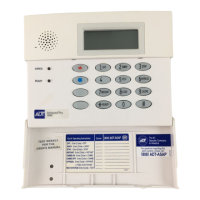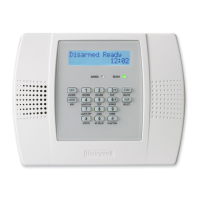4-3
*36
Entry Delay 2
See *35 above for entries.
See *35 above for explanation.
*38
Confirmation Of Arming Ding
0 = no ding
1 = confirmation ding after arming
system
2 = confirmation ding after arming from
RF button or RF touchpad only
(except 5827, 5827BD)
Confirmation of arming is 1/2 second external sounder “ding.”
If “1” selected, ding occurs when closing report is sent if
open/close reporting is enabled, or at the end of Exit Delay.
If “2” selected, ding occurs upon reception of the wireless
arming command.
UL installations: must be “1” for UL Commercial Burglar
Alarm installations.
*39
Power-Up In Previous State
Feature always enabled; field removed
in this control.
When the system powers up armed, an alarm will occur 1
minute after arming if a zone is faulted.
Note that if the previous state was armed Away or Stay, the
system ignores sensor changes for 1 minute, which allows
time for sensors such as PIRs to stabilize.
Dialer Programming (
∗
∗∗
∗
40 –
∗
∗∗
∗
50)
FIELD
TITLE and DATA ENTRIES EXPLANATION
*40
PABX Access Code or Call
Waiting Disable
Enter up to 6 digits if PABX is needed
to access an outside line or enter call
waiting disable code (*70) if call waiting
is being used on the phone line.
Do not fill unused spaces.
0–9, # + 11 for ‘∗’, # + 12 for ‘#’, # + 13
for a pause (2 seconds)
To clear entries from field, press ∗40∗. If fewer than 6 digits
need to be entered, exit by pressing [∗], which advances to the
next field.
SIA Installations - Call Waiting: If the subscriber’s phone
service has “call waiting” (and is not using PABX), enter “*70”
(“# + 11”) plus “# + 13” (pause) as the PABX entry and set call
waiting disable option in field *91 to disable “call waiting”
during control panel calls. If the subscriber does not have “call
waiting” and is not using PABX, make no entry in this field.
NOTE: The call waiting disable feature cannot be used on a
PABX line.
IMPORTANT: Using Call Waiting Disable on a non-call
waiting line will prevent successful communication to the
central station.
*41
Primary Phone No.
Enter up to 20 digits. Do not fill unused
spaces.
0–9, # + 11 for ‘∗’, # + 12 for ‘#’, # + 13
for a pause (2 seconds)
If you enter fewer than 20 digits, exit by pressing [∗]. To clear
entries from field, press ∗41∗.
Backup reporting (in which 8 calls are made to the secondary
phone number if no kissoff is received after 8 attempts to the
primary number) is automatic only if there is a secondary
phone number (field ∗42).
*42
Secondary Phone No.
Enter up to 20 digits. Do not fill unused
spaces.
0–9, # + 11 for ‘
✱
’, # + 12 for ‘#’, # + 13
for a pause (2 seconds)
If you enter fewer than 20 digits, exit by pressing [∗]. To clear
entries from field, press ∗42∗. See backup reporting note for
field ∗41.
*43
Partition 1 Subscriber ID No.
Enter digits 0–9; # + 11 for B, # + 12 for
C, # + 13 for D, # + 14 for E, # + 15 for
F.
Enter 4 or 10 digits, depending on report format selection in
field *48. To clear entries from field, press ∗43∗.
Automatically puts same entries into field *45.
*45
Partition 2 Subscriber ID No.
Enter digits 0–9; # + 11 for B, # + 12 for
C, # + 13 for D, # + 14 for E, # + 15 for F.
Enter 4 or 10 digits, depending on report format selection in
field *48. To clear entries from field, press ∗45∗.
*47
Phone System Select
If Central Station Receiver is not on
WATS line: 0 = Pulse Dial; 1 = Tone
Dial
If Central Station Receiver is on WATS
line: 2 = Pulse Dial; 3 = Tone Dial
Select the type of telephone service.
